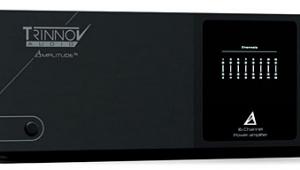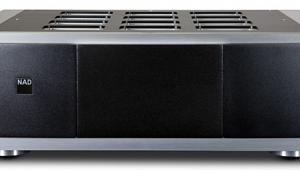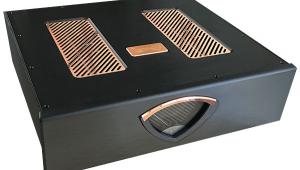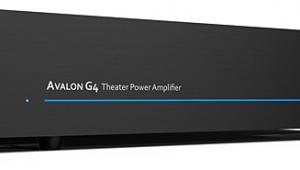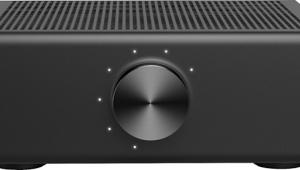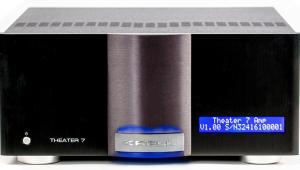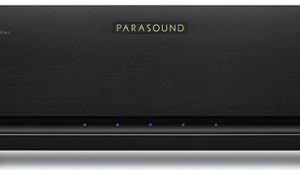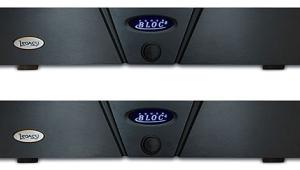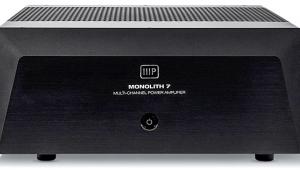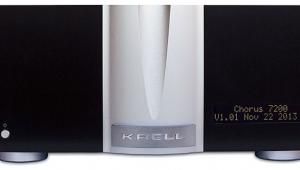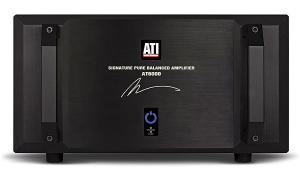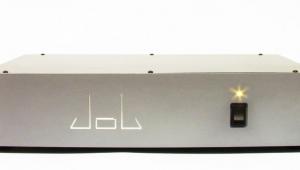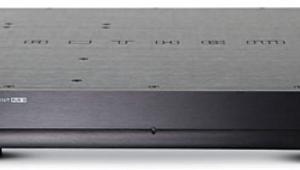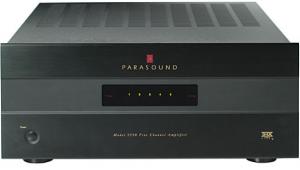Review: Blue Aura v30 Blackline Tube Desktop System Page 2
Measurements
Frequency response, speaker
85 Hz to 20 kHz ±3.6 dB 0° on-axis, ±3.1 dB avg. 0° to 30°
Sensitivity, speaker
84.6 dB (1 watt/1 meter anechoic, avg.300 Hz to 10 kHz)
Impedance, speaker
7 ohms avg., 3.9 ohms/-8°min.
Bass limit, speaker
82.7 dB at 50 Hz
Frequency response, amplifier
20 Hz to 20 kHz, +0/-1.08 dB
Output power, amplifier (1% THD)
12.7 W at 8 ohms
S/N ratio, amplifier (1 W, A-weighted)
-92.5 dB
Total harmonic distortion, amplifier (1 W/1 kHz/8 ohms)
0.199%
To measure the quasi-anechoic frequency response of the v30 speaker, I set it atop a 2-meter stand and placed the microphone at a distance of 1 meter. (Quasi-anechoic measurements eliminate reflections from surrounding objects to simulate measuring in an anechoic chamber.) The microphone was placed on the same axis as the tweeter, then moved around slightly to try to get the flattest response. I then ran a ground-plane measurement at 1 meter to get the bass response. To create the graph shown here, I spliced the bass response to the average of quasi-anechoic measurements of the left channel only taken at 0°, ±10°, ±20°, and ±30°. I used a Clio FW analyzer in MLS mode for the quasi-anechoic measurements and log chirp mode for the close-miked sweep, using an Outlaw Model 2200 amplifier to drive the speaker. The quasi-anechoic measurements were smoothed to 1/12th octave. The blue trace shows the 0° on-axis response, while the green trace shows the averaged response.
This is a pretty well-designed little speaker. Frequency response does show one significant tonal balance issue: an upper mid/lower treble emphasis between 1.5 and 4.5 kHz, which will probably make the sound slightly bright and perhaps emphasize sibilance in voices a bit. But still, the averaged response is close to ±3 dB, and it's actually flatter than the on-axis response, which shows that the speaker's dispersion is excellent. Given its fairly decent sensitivity of 84.6 dB (and that's anechoic-figure +3 dB or so indoors) and mild impedance curve, it's a speaker that a tiny amp can drive reasonably well.
I measured the amplifier's performance using my Clio FW audio analyzer. Sadly, I couldn't find one of my load resistors so I couldn't do a 4-ohm power measurement. (Don't tell me that's never happened to you.) Anyway, the speaker included with the system is close to 8 ohms, so the power here is close to what you'll really get with the system.
Blue Aura doesn't specify the conditions under which the amplifier's 20-watt power rating were measured. In my measurements, I got 20 watts output at 18% THD into 8 ohms at 1 kHz. A more real-world measurement, at 1% THD, gave me 12.7 watts.
Measurements of signal-to-noise ratio, frequency response, and distortion at low signal levels are all pretty good and all exceed the manufacturer's spec. - Brent Butterworth
Bottom Line
For your $549 you get a beautiful object with lovely finish details and swank faux-leather appointments, effective, stable rubber stands, and all-round impressive design. It is, admittedly, a little expensive, and I would like to see Blue Aura offer the little speakers separately (they do offer an active version, the WS30i, with 25 watts of Class D on a side, for $279/pair); those are real winners and would work well with so many of the little amps on the market these days.
Still, the amp is a solid performer, and with two analog inputs it gives you plenty of connectivity for the average desktop application. Especially given the price, I would really have liked to see a better onboard USB decoder, but considering the overall quality of the system, many users may be interested primarily in using this with the DAC of their choice anyway, so it's an understandable design decision.
For a complete, low-fuss, ultra-small system, this would make a nice pairing with something like the ADL/Furutech GT40, which would give you a much better DAC and headphone amp, along with a phono stage. 'Cause you might as well be running vinyl through that tube amp, no?
Something to think about for the space challenged among us.
- Log in or register to post comments
